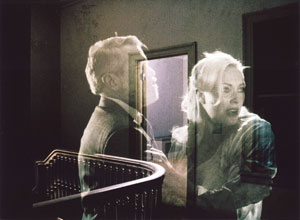|
|
|||||
|
TRACING THE DECAY OF FICTION |
|||||
LABYRINTH PROJECT The Labyrinth Project is an art collective and research initiative on interactive cinema and database narrative at the University of Southern California’s Annenberg Center for Communication. Under the direction of cultural theorist Marsha Kinder since 1997, this initiative works at the pressure point between theory and practice. After hosting “Interactive Frictions,” a groundbreaking international conference and exhibition at USC in 1999, Kinder decided to focus on producing interactive narratives and installations in collaboration with visual artists and writers known for their experimentation with nonlinear forms. She assembled a group of talented digital artists --headed by Rosemary Comella, Kristy H.A. Kang, Scott Mahoy and associate producer and curator JoAnn Hanley--to oversee these productions. These collaborations also involve the participation of talented students from several divisions within USC’s School of Cinema-Television--animation, critical studies, interactive media, and production. No matter whether our primary collaborator is a filmmaker or writer, we choose to make our projects cinematic. For, Labyrinth is committed to creating a productive dialogue between the immersive language of cinema and the interactive potential and database structures of digital media. PAT O'NEILL O'Neill's
first feature, "Water and Power," a journey through a California
of the imagination, was a Sundance Grand Jury Prize winner in 1990
and was hailed as a touchstone for filmmaking in the future. Several
of the 14 avant-garde 16mm short films he produced between 1963 and
1982 are considered classics (especially "7362," "Runs
Good," and "Saugus Series"). All are in international
distribution and in the collections of educational institutions and
museums, from the Cinematheque Francáise to the Austrian Film
Archives. O'Neill moves in two worlds: he and his visual effects company,
Lookout Mountain Films, have achieved some of the best-known effects
for Hollywood films since the 1970s, from "Return of the Jedi"
through "The Game." He has also been a member of the experimental
film scene that was so vibrant in the '60s and '70s, where he pioneered
the sort of free-flowing, manipulated live-action imagery that is
now all around us.
|
Texte en anglais Based on Pat O’Neill’s 35 mm film, The Decay of Fiction (2002), this interactive project is an archeological exploration of the Hotel Ambassador, a vintage building now in ruins. Erected in 1920, the hotel played a crucial role in the development of Los Angeles and its urban sprawl. Well known for its glamorous Cocoanut Grove nightclub where Hollywood stars and movie moguls mingled with foreign dignitaries and downtown power brokers, the Ambassador was also the site of one of our nation’s most disturbing events—the 1968 assassination of Democratic Presidential Candidate Robert Kennedy.
|
||||
|
|||||


